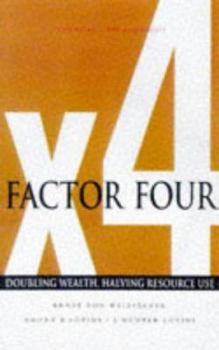Factor Four: Doubling Wealth, Halving Resource Use - A Report to the Club of Rome
Select Format
Select Condition 
Book Overview
This report answers the 1971 report published by the Club of Rome that argued the world was going to run out of essential resources. It offers a solution, arguing for more efficient use of resources,... This description may be from another edition of this product.
Format:Paperback
Language:English
ISBN:1853834068
ISBN13:9781853834066
Release Date:January 1998
Publisher:Routledge
Length:360 Pages
Weight:0.10 lbs.
Dimensions:0.8" x 5.4" x 8.5"
Related Subjects
Business Business & Finance Business & Investing Conservation Economics Engineering Environmental Economics Industrial, Manufacturing & Operational Systems Industries & Professions Information Management Management Management & Leadership Nature Nature & Ecology Oil & Energy Popular EconomicsCustomer Reviews
2 ratings
Getting more for less
Published by Thriftbooks.com User , 19 years ago
The theme of the book is getting more for less, with the assertion, with copious examples, that the knowledge, technologies and in many cases commercial experience exist to double outcomes while halving resource use across a very wide range of economic activity. Further, these gains are often available very inexpensively and have the potential to yield large increases in profitability as well as in useful outcomes. The report gives examples and then goes on to discuss how to bring about useful change. A major theme is that the conventional wisdom of both engineering and economics currently work against achieving material and energy productivity, but do not need to do so. There is an underlying theme of the need to change economic incentives and measures within the market system, which goes back at least to Hawken's 1993 The Ecology of Commerce. The thrust of the book is to demonstrate: * that, for historical and other reasons the capitalist world is extremely wasteful of resources, particularly materials, energy and transport (effectively another manifestation of energy use), despite the fact that technologies and good examples exist which can lead to dramatic reductions. * that the failure to take these improvements up is not that they are too costly - in many cases introducing the improvements reduces capital costs - but - a failure to design or operate systemically, - the slow accretion in accepted practice (such as car design and manufacture) of 'bells and whistles' that increase weight and energy use but not performance; - a fixation on reducing labour content at the expense (typically) of increased energy and material consumption through the system; and - perverse incentives that are built into the economic calculus of business and economic success (including for example externalities). * that the market is neither a god nor a devil. It is a tool that produces different results according to the guidelines and measures within which it operates. The current guidelines and measures were developed in an era when the natural environment was considered as an inexhaustible 'free good' and need to be changed; and * that transition to a sustainable world is possible on reasonable assumptions if we all get serious about making use of resource saving technologies and measure our progress in more appropriate ways. The many examples in Part 1 provide a useful source of ideas for improving economic performance while simultaneously benefiting the environment. The remaining three parts summarize and add to proposals for reconciling corporate, economic and ecological sustainability. Note that, while it is fairly comprehensive in its scope, there are some opportunity areas that it does not explore, such as the scope for 'ecological industrial parks' in which industries are clustered such that the waste of one is economic input for another. The 'sustainability' literature is often accused of being moralistic and lacking in com
Interesting precursor to "Natural Capitalism"
Published by Thriftbooks.com User , 20 years ago
Many of the anecdotes related in this book appear again in "Natural Capitalism", a more recent work by Lovins et al. There are enough differences, however, to merit an inspection. The authors have a real knack for research. You'll probably be surprised by some of the facts they lay before you, e.g. 50-100 kg of nitrates fall out of the sky per hectare in central Europe.





